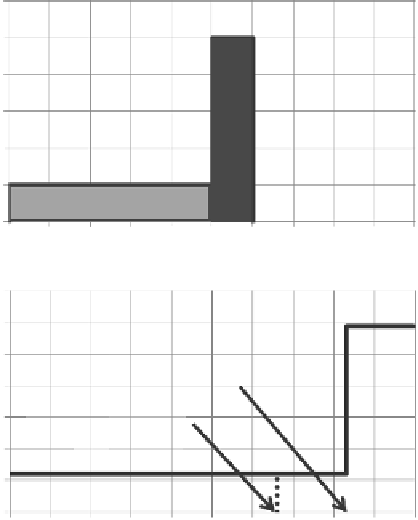Environmental Engineering Reference
In-Depth Information
3.0
2.5
2.0
θ *: Critical
frequency of
good wells = 0.83
1.5
1.0
0.5
P
= 0.5
0.0
-1.0
-0.8 -0.6 -0.4 -0.2
0.0
0.2
0.4
0.6
0.8
1.0
Monetary value (development cost)
3.5
3.0
2.5
2.0
1.5
1.0
0.5
0.0
θ *: Critical frequency
of good wells = 0.83
Prior expected
frequency of
good wells
0.0
0.1
0.2
0.3
0.4
0.5
0.6
0.7
0.8
0.9
1.0
θ : Frequency of good wells in the new play
Figure 13.44
Prior probability distributions for decision consequences and for frequency of good wells in
developing an unconventional gas reservoir.
θ*, then the play will be profitable (i.e., consequence greater than zero). Likewise, if the
frequency is less than θ*, then the play will not be profitable. The frequency of good wells
in the new play is uncertain.
The prior probability distribution for the frequency of good wells in the new play is
intended to reflect the case of no information or maximum uncertainty. A theory called
Decision Entropy Theory (Gilbert et al. 2012; Habibi et al. 2014) is currently under devel-
opment to establish a “non-informative” prior probability distribution in the context of
decision making. The principle of this theory is to establish prior probabilities for variables
in a decision by maximizing the entropy of the outcomes of the decision and what might or
might not be learned about these outcomes.
Figure 13.44
shows the product of this theory in
this application; the entropy of the decision is maximized such that there is a 50-50 proba-
bility that developing the play will be preferred (i.e., that it will be profitable if implemented)
and there are equal probabilities for the possible profits if development is preferred and
possible losses if development is not preferred (
Figure 13.44
).
Note that this play is rather
risky in that a high frequency of good wells is required for it to be profitable,
θ
*
= 083
The
noninformative prior probability distribution for the decision consequence is then mapped
into a noninformative prior probability distribution for the uncertain model parameter, the
frequency of good wells in the new play (
Figure 13.44
).
Information will generally be available before making an investment decision on a new
play. Specifically, the performance of similar wells in similar geologic conditions, or analog
fields, will be used in making the decision to develop the new play. Consider the case where
an analog field had 20 good wells out of 100 total wells. If this information is assumed to
apply directly to the new play, then we would choose not to develop it because the frequency
.
.

Search WWH ::

Custom Search